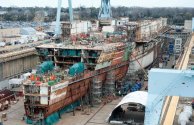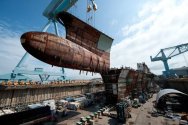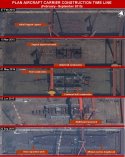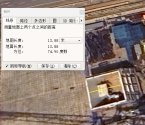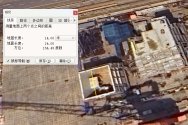You are using an out of date browser. It may not display this or other websites correctly.
You should upgrade or use an alternative browser.
You should upgrade or use an alternative browser.
00X/004 future nuclear CATOBAR carrier thread
- Thread starter AETHER
- Start date
A more likely explanation, if this is indeed the CVN, is that the bow section is not fully accounted for in keel blocks. If you look at how the Ford class is build, a substantial section of the bow is not attached at initial assembly. Even the keel blocks were added later on.
View attachment 157550
View attachment 157551
If this thing is a carrier, I agree that is a plausible explanation.
===
I think it's useful for the community at large to agree on a set of common positions so that this doesn't become a recurrent debate on the forum as well as so it doesn't keep leaking out to other places (Twitter etc).
IMO, the common underlying positions that can be reasonably held at this stage include:
1. We cannot definitively rule out the possibility that these modules seen so far are for a carrier.
- The modules so far and their spacing between each other are not basis to conclude anything, because there is always a possibility that modules can be repositioned.
- The "length" indicated by the keel blocks in the drydock are not a basis to conclude the length of the overall ship, because additional keel blocks can always be added later as construction progresses
2. We cannot definitively say these modules seen so far, are for a carrier.
- While there are lots of circumstantial indicators from visual indicators they may be for a carrier -- such as their long time spent in drydock, their beam and overall geometry -- the images are not yet so conclusive that we can confidently call it yet. It is not helped that the keel blocks length so far is shorter than what would be expected for a carrier, and we do not definitively know if the keel blocks will be lengthened either.
- We've had indirect rumours and contracting evidence that this could be for a carrier (or even a CVN). But the lack of definitive PRC language grapevine in stating something like "yes, the modules we see in these pictures are for a carrier" should give us pause. Perhaps it is because they are playing it safe, or not wanting to give the game away, whatever. The issue is that the grapevine/credible rumours are not yet 100% definitive.
I would encourage people to view the debate as one of "having sufficient overwhelming basis/evidence that is enough to convince the other side of the argument in a manner that they cannot refuse it". If that cannot be achieved, then it should be stalemate, and acknowledging the limitations of either sides of the argument.
For those who are adamant about this being a carrier, I'd like some explanations on some visible oddities.
1) Why is the drydock seemingly broken up into 3 sections I've highlighted them in Yellow.
2) Why do the keel blocks in section 2, the (middle section). Taper near the end, but the blocks in section 1, are wider than 2.
3) Why is there still basically nothing present in section 3.
I think these are the prime oddities that sow most of the doubt on why this can't be a carrier for sure, as the modules in the drydock are presenting a confusing construction.
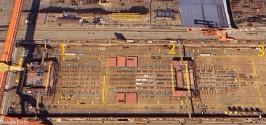
1) Why is the drydock seemingly broken up into 3 sections I've highlighted them in Yellow.
2) Why do the keel blocks in section 2, the (middle section). Taper near the end, but the blocks in section 1, are wider than 2.
3) Why is there still basically nothing present in section 3.
I think these are the prime oddities that sow most of the doubt on why this can't be a carrier for sure, as the modules in the drydock are presenting a confusing construction.

Yeah unfortunately it's still too early to tell with certainty if this is a carrier or not. There are significant details that suggest it is a CVN but there is just not enough actual proof to be sure. The worst part is the waiting, it's been in this limbo state for months which is very frustrating but the fact is we just have to keep waiting to be sure.
I’ll try my best answer this.For those who are adamant about this being a carrier, I'd like some explanations on some visible oddities.
1) Why is the drydock seemingly broken up into 3 sections I've highlighted them in Yellow.
2) Why do the keel blocks in section 2, the (middle section). Taper near the end, but the blocks in section 1, are wider than 2.
3) Why is there still basically nothing present in section 3.
I think these are the prime oddities that sow most of the doubt on why this can't be a carrier for sure, as the modules in the drydock are presenting a confusing construction.
View attachment 157555
1. Modern warships are built in sections not all at once, this isn’t exactly odd or un unusual.
2. Carriers don’t all have the same width so tapering near the end isn’t odd, I can’t say why without knowing the design of the ship China wants
3. carriers aren’t built in one piece some sections are built after others and this is likely why we don’t see much at section 3 compared to section 1 and 2.
This is what I think and know about modern warships but take it with a grain of salt, we can’t tell until it’s later on in the building stage
For those who are adamant about this being a carrier, I'd like some explanations on some visible oddities.
1) Why is the drydock seemingly broken up into 3 sections I've highlighted them in Yellow.
2) Why do the keel blocks in section 2, the (middle section). Taper near the end, but the blocks in section 1, are wider than 2.
3) Why is there still basically nothing present in section 3.
I think these are the prime oddities that sow most of the doubt on why this can't be a carrier for sure, as the modules in the drydock are presenting a confusing construction.
View attachment 157555
These are oddities, but not what casts doubt on it being a carrier. In order to do that these oddities need to suggest something other than a carrier, but they don't. These oddities are just that, oddities, as they neither point toward nor away from the ship being a carrier.

Brief Explanation of This Already-Public Patent:
- Purpose of the test facility:
The facility is built for land-based integration and testing of the power system, which is the final step before installation on the ship. - System configuration:
Inside the facility, there are gas turbines, diesel engines, a power output device, and a water dynamometer.
The power output device is listed separately, indicating that it's not mechanically coupled with the gas turbines or diesel engines. It is only connected to the water dynamometer, implying that this marine power system is neither mechanically propelled nor hybrid-electric. - Power Units Setup:
The facility includes 4 gas turbines and 10 diesel engines, totaling 14 power units.
Normally, a large conventional-powered cruiser or destroyer would not have more than 10 power units, mainly because such ships need to reserve a lot of internal space for Vertical Launch Systems (VLS), leaving little room for power system.
So even if high power output is required, the selected power units must be compact and high-output.
If the power requirement is met by stacking many units, it will inevitably limit the number of VLS or other onboard weapons.
- Uses an Integrated Electric Propulsion (IEP) system, and is equipped with at least two propulsion shafts and propellers (one on each side — port and starboard).
- The project is not yet at the stage of final hull assembly, since the power system hasn't finished testing.
- The ship has very spacious compartments below the waterline, with ample room from bow to stern to accommodate large equipment, and this space is not interrupted by weapon compartments like VLS and supporting equipment, allowing for a continuous internal layout.
PS: This system cannot be for the 076 if anyone is wondering because the IEPS for 076 has only two gas turbines paired with 6 diesel generators.

